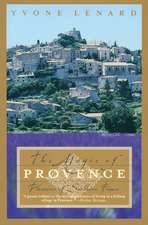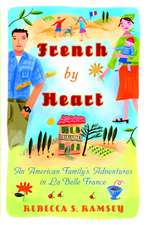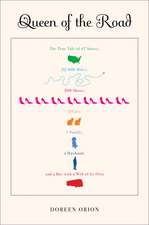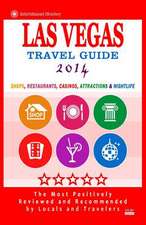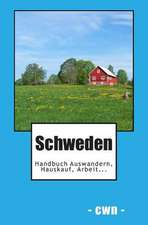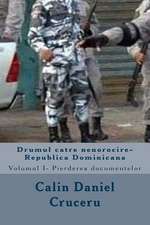The Whole Fromage: Adventures in the Delectable World of French Cheese
Autor Kathe Lisonen Limba Engleză Paperback – 24 iun 2013
In The Whole Fromage, Kathe Lison sets out to learn what makes French cheese so remarkable—why France is the “Cheese Mother Ship,” in the words of one American expert. Her journey takes her to cheese caves tucked within the craggy volcanic rock of Auvergne, to a centuries-old monastery in the French Alps, and to the farmlands that keep cheesemaking traditions alive. She meets the dairy scientists, shepherds, and affineurs who make up the world of modern French cheese, and whose lifestyles and philosophies are as varied and flavorful as the delicacies they produce. Most delicious of all, she meets the cheeses themselves—from spruce-wrapped Mont d’Or, so gooey it’s best eaten with a spoon; to luminous Beaufort, redolent of Alpine grasses and wildflowers, a single round of which can weigh as much as a Saint Bernard; to Camembert, invented in Normandy but beloved and imitated across the world.
With writing as piquant and rich as a well-aged Roquefort, as charming as a tender springtime chèvre, and yet as unsentimental as a stinky Maroilles, The Whole Fromage is a tasty exploration of one of the great culinary treasures of France.
Preț: 114.19 lei
Nou
Puncte Express: 171
Preț estimativ în valută:
21.85€ • 22.87$ • 18.08£
21.85€ • 22.87$ • 18.08£
Carte tipărită la comandă
Livrare economică 05-19 aprilie
Preluare comenzi: 021 569.72.76
Specificații
ISBN-13: 9780307452061
ISBN-10: 0307452069
Pagini: 288
Ilustrații: MAP
Dimensiuni: 146 x 193 x 21 mm
Greutate: 0.29 kg
Ediția:New.
Editura: BROADWAY BOOKS
ISBN-10: 0307452069
Pagini: 288
Ilustrații: MAP
Dimensiuni: 146 x 193 x 21 mm
Greutate: 0.29 kg
Ediția:New.
Editura: BROADWAY BOOKS
Notă biografică
KATHE LISON, A native of Wisconsin, "America's Dairyland," is an award-winning essayist whose work has appeared in numerous literary journals, and a recipient of an Emerging Artist Grant from the Utah Arts Council. She lives in Arizona.
Extras
1
“The French are sawed-off sissies who eat snails and slugs and cheese that smells like people’s feet.”
—P.J. O’ROURKE
The blade of Napoleon’s sword scythed air redolent of roasted meat as the man who would one day be emperor severed the top of the cheese before him. Its point landed with a soft plop.
Moments earlier, Charles-Maurice de Talleyrand-Périgord, renowned French diplomat and the owner of the Château de Valençay, had noted the scowl creeping across the general’s face. The stain of red on his cheeks had nothing to do with their recent scorching by an Egyptian sun, nor the warm breezes wafting through from doors flung open to a gravel courtyard. Inside the room, a hush fell over the guests gathered around the mahogany table, the silver-plate carving stand, the china banded in moss green and gilt. Outside, below the courtyard, the Nahon River, one of the numerous tributaries whose waters eventually join the Loire, flowed in a quiet, dark streak.
Not long before, France had triumphed at the Battle of the Pyramids, and the success of Napoleon’s North African campaign seemed assured. Back then, Talleyrand had relished the pyramid-shaped fromage produced on nearby farms. Why had he, Talleyrand, so skilled in the art of subtle manipulation, not considered how Napoleon might feel about the cheese now that the general had returned in defeat? The sound of the courtyard fountain, its spout ringed by cherubic stone children, trickled into the silence; a wine bottle, nestled in one of two marble ba- sins attached to the walls, shifted with a dull clunk. The guests, many of whom had jumped from their seats when the general called for his sword, stood without moving. Encumbered by the brace he wore for a chronic limp, Talleyrand remained near his chair, the froth of lace at his throat quivering. Napoleon spared none of them a glance as he set the sword next to the serving plate, nabbed a morsel of the now-decapitated cheese, and chewed.
This is one account—shamelessly embellished—of how the goat cheese known as Valençay came to be shaped like a flattened pyramid. Other stories have Talleyrand beheading the cheese; in still others, the peasants around Valençay do the deed. According to yet another variation, Talleyrand, wanting to enjoy the fine goat cheese from his country estate while in Paris, ordered his steward to alter the cheese molds before sending the tasty chèvres to the city, where the emperor might see them. But the most popular version is the one in which Napoleon himself lops the tip off—a story with a heady mix of celebrity, defiant Frenchness, a hint of danger, and of course, a dash of cheese.
My own story with French cheese began less dramatically, with a trip to Paris. Charles de Gaulle is supposed to have said, “How can anyone govern a country that has 246 different kinds of cheese?” But de Gaulle’s number was only one estimate, as the book I bought one Christmas Eve at Charles de Gaulle Airport made clear: a Dorling Kindersley “visual guide to more than 350 cheeses from every region of France.” Though I didn’t realize it at the time, the actual number of French cheeses is one of those great unknowables, like the place the other sock disappeared to or whether or not God exists. Even the ubiquitous de Gaulle quote doesn’t stay constant—sometimes he laments the existence of 258 cheeses, sometimes 227, sometimes 324. Other sources say it wasn’t even de Gaulle but rather Winston Churchill who wanted to know “How can you govern a country with over 300 cheeses?”—to which the French president supposedly snapped back, “There are at least 350.” This number at least squares with that of my guidebook, but falls far short of estimates that put the number of French cheeses as high as 650. Six hundred and fifty. Cheeses. All produced in a country smaller than Texas.
I’d bought the book to learn more about the cheeses that my partner, Chris, and I were smuggling out of the country in our suitcases. One of them, a pungent, gooey cow’s milk cheese from the French Juras called Vacherin Mont d’Or, qualified as con- traband: a raw-milk cheese—i.e., an unpasteurized one—aged fewer than sixty days. Completely illegal in the United States, though at the time it didn’t occur that something as innocuous- seeming as cheese could turn us into petty criminals. The cheese was cushioned in a suit newly bought for Chris; he was making elaborate plans for fumigation even before we left French soil. When I showed him the book, Chris took one look at the cover and said, “Three hundred and fifty cheeses! That’s practically a different cheese for every day of the year.”
“I know,” I responded, nearly whispering in awe, before plunking into a chair near our gate.
I opened the book—and encountered pictures so vivid I had to resist an urge to press my nose to the pages to see if I could smell them. There were cheeses with wild mulberry leaves pressed into their tops; cheeses bound with rushes; cheeses covered in ash, in cumin, in raisins, in bits of grape skin; cheeses furred with long hairs of mold; cheeses in the shape of bricks, logs, bells, sheep turds; gigantic round cheeses that could crush a poodle; and tiny goat cheeses so tender-looking you wanted to pick them up and soothe them. As I turned each glossy page, revealing another and yet another fabulous, even fantastical, cheese, I began to have questions. Why produce this crazy number of cheeses? I mean, why not just one nice sharp cheddar?
The French, I would eventually discover, have so many cheeses and so much lore to go with them that there’s even a Larousse des fromages—a French cheese encyclopedia. What was the deal with the French and all this fromage? I wanted to find out.
Given my upbringing, you might say my interest in cheese was inevitable. I confess: I am a Cheesehead. By this, I don’t just mean that I love cheese (though, I do) or that I have a cheese obsession (though, I suppose you could say that), but that I was born and raised in Green Bay, Wisconsin, the place where otherwise sane-seeming folk regularly don foam wedges shaped like giant slices of Gruyère (though colored a bizarre, alien yellow we can only hope real Gruyère never attains). On Packer Sundays, these wedges crown the heads of the faithful at Lambeau Field, one part of a football, beer, and cheese-bratwurst trifecta.
When it comes to cheese, people from Wisconsin just can’t help themselves. License plates proclaim the state “America’s Dairyland,” and picture a happy little red barn, happy little flapping birds, and a happy orange sunset. Some people believe that Colby, invented in Colby, Wisconsin, may have been the first truly American cheese. Wisconsin is the nation’s largest producer of cheese, although California has long been on its tail, a fact that pisses off Wisconsinites to no end. A New York Times report outlining the looming takeover quoted various cheese people in my home state: “Say cheese and you say Wisconsin,” claimed one. “When you drive through Wisconsin, what do you see but cheese? It’s who we are,” said another. As one journalist put it, “Cheese is a kind of secular religion in the upper Midwest, particularly in Wisconsin.”
My maternal grandfather kept and milked a dozen Holsteins on a farm north of Green Bay, and on my father’s side, my great- great-grandfather started a dairy that remained in the family well into the 1960s; as a boy, my grandfather rode along in the milk wagon making deliveries. In my kitchen sits an old bottle, the words “Lison’s Dairy” scrolling across its front in brown letters. I heard about that mom-and-pop operation—the empty storefront was a few blocks from my grandparents’ Green Bay home—all the time as I was growing up: “You should have tasted their chocolate milk!” As far as I know, no one in the family made cheese themselves, but my progenitors were certainly up to their eyeballs in udders.
Still, the Wisconsin cheese I ate in the 1970s could hardly be considered “artisanal.” Even if such cheeses had been available, I was the trailer park kid of a single mother just scraping by, sometimes with the help of food stamps. The cheese we knew was a somewhat bland, orange variety that came from the local food pantry in brown cardboard boxes stamped “U.S.D.A.,” or the sort found in Kraft Macaroni & Cheese—which, to be technical, is not really cheese at all. Mom used to pull a chair up to the stove and let me stir the elbow noodles, then help add the milk, butter, and garish powder that made the mess a cheesy delight.
Many of my organic-only, low-fat, health nut friends are horrified when I own that even now, as an adult, I still eat Kraft Mac & Cheese. I have upgraded to the more refined “Three Cheese with Mini-Shell Pasta” version, but it comes in that same blue box, an old pal on the cupboard shelf.
In other words, my childhood cheese, like that of most Americans, was industrial cheese. All of it was a far cry from raw-milk cheeses made high in the French Alps in wee chalets where they’ve been making cheese for centuries, or from cheeses with marvelous crusty rinds the color of toast, or from still others that you can break into and eat with a spoon. Wisconsin might be really into cheese, but it doesn’t come close to rivaling France—a fact I largely ignored when I spent a semester in Paris during my early twenties. Back then, in my fresh-from-the-Midwest naïveté, I thought even chèvre suspect—who on earth had ever heard of cheese made with milk from a goat?— and ate tiny Babybel cheeses on butter-smeared baguettes. I thought Babybel—a mild, white, processed cheese that could be considered the French equivalent of a plastic-wrapped slice of American—the most marvelous cheese ever. Now most of us can likely find Babybel at our local supermarket, but back then, it was exotic—it was French!—and I munched away happily at my Babybel sandwiches in various Parisian locales, trying to affect an authentic air. Yet I remained ignorant. That much was obvious as I stood in Charles de Gaulle Airport nearly a decade later holding a book full of cheeses I knew nothing about.
Certainly I'm not the first American to be smitten by French cheese. Americans have been coveting fromage at least since the middle of the nineteenth century; we began importing Roquefort in the 1830s and ’40s, and by the late 1880s were bringing it in at a rate of five million kilos a year. Even so, it’s only in the past three or four decades—as more and more Americans have traveled to France and had the opportunity to taste the local specialties— that we’ve developed a serious craving for it. The publication of two books in particular helped to intensify this hunger. The first was Le guide du fromage, published in the States in 1973 as The Complete Encyclopedia of French Cheese. The author was Pierre Androuët, the proprietor of a huge handlebar mustache and an international cheese superstar, the “pope” of French cheese. “Pierre Androuët invented everything,” recalled French cheese monger Hervé Mons in 2005, shortly after Androuët’s death. “He opened the way, showed the path. [ . . . ] He was one of those visionary men like Edouard Michelin, who wasn’t con- tent merely to sell tires, but thought about everything that went along with that: road maps, good restaurants, the necessity of customer service [ . . . ].” Though one might argue that Pierre’s father, Henri—who founded La Maison Androuët at 41 rue d’Amsterdam in Paris, one of the greatest temples to fromage that has ever existed—was the real visionary, the point about Pierre Androuët is well made. For Americans who knew little about French cheese, Androuët’s work demystified a number of pre-viously impenetrable fromages, and whet our appetites for more than Velveeta.The other book was written by the monocled, irascible, and very British figure of Patrick Rance. At a bend in the road in the village of Streatley, an hour or so outside of London, you can still see the hobbit-size redbrick storefront out of which he famously sold hundreds of different cheeses alongside dog food and shoelaces. Unlike Androuët, who set out to create gastronomic legend, Rance was more of a cheese hobbyist whose passions had run amok.
Having sparked a renaissance in British farmhouse cheese with his store, he next bought a house in Provence and embarked on six years of travel across France in order to write The French Cheese Book, which appeared in 1989. In it, he actually catalogues more than 650 types of fromage— stopping around 750. “I should have liked to produce a more comprehensive book,” he writes mournfully, “but life is too short.” Pierre Androuët himself called Rance’s exhaustive guide “the best of all,” and it remains one of the definitive texts on French cheese.
Androuët’s work, coming at the beginning of the 1970s, signaled the start of a profound shift in the American cheese scene. In his 1976 book The World of Cheese, Evan Jones—husband to Judith Jones, the editor who discovered Julia Child—wrote of a proliferation of Parisian-style cheese shops across America. This might have been mostly wishful thinking on Jones’s part; I myself don’t recall seeing so much as Brie or Camembert in anyone’s house until the 1980s or ’90s, and then it was the awful, bland deception foisted on the American public by makers such as Président. Still, those sad, oven-warmed Bries signaled brewing change. In New York, cheese mongers such as Rob Kaufelt of Murray’s Cheese Shop and Steven Jenkins of Fairway—Rance’s encyclopedic volume in hand—were importing more French varieties than most Americans had ever imagined existed. By 2004, Cynthia Zarin was writing in The New Yorker about cheese as a cultural happening: “In the past few years, the cheese landscape in New York—what kind of cheese you can buy, who makes it, who’s eating it, and where—has changed dramatically; it’s like the moment when black-and-white TV turned into full-spectrum color.” The days when wine-soaked balls covered in sliced almonds were the height of American cheese sophistica- tion were quickly becoming a memory.
Some of these cheeses, of course, were British or Italian or Spanish. But most of them were French. “There is nowhere like France when it comes to cheese,” writes Liz Thorpe, formerly of Murray’s, the celebrated New York cheese store. “The French make the fluffy, the sexy, the drippy, the runny, the delicate, the stoic, the [entire] crumbling, hulking, racy, lacy, oozing spec- trum . . .” France, she concludes, “is the Cheese Mother Ship.” And if the past several decades are any indication, we Americans would like nothing better than to be beamed aboard.
Our newfound enthusiasm for artisanal cheeses, however, remains tempered by a certain amount of consternation. The French are used to the many alien forms that curdled milk can assume—I once watched a group of French truckers tuck matter-of-factly into a platter of gooey cheeses that would have sent their Stateside counterparts running. We Americans, however, sometimes get a little rattled when forced out of our Monterey Jack comfort zone. Not only is the world of fromage filled with hunks of things that smell like armpits or come covered in green crusties, but there’s also the sheer number of French cheeses to contend with. I’d thought my impulse purchase from the airport bookstore would help me to master this strange new world, but as my questions multiplied, I realized I’d underestimated my subject.
And I realized typologies and glossy pictures would take me only so far. Not only that, but what I truly yearned for was a different, more intimate kind of knowledge. I wanted to see where the cheeses came from, talk with the people who made them, lift the cheeses from the often stultifying pages of “gourmet” guides, replete with tips on where to stick them on a serving plate. I wanted them to come alive. For cheese is alive. Cheeses breathe; they evolve, gain complexity; they peak. They can be mishandled—even killed. (As Pierre Androuët warns, “Never put them in the freezer. That would be an act of murder.”)
The only thing for it was to leave the guidebooks behind, and so I set off into the “wilds” of the French countryside. There, I quickly discovered the delights of going where the fromage takes you. Study a map of France, and you’ll find that cheeses—often named after the hamlet from which they came—are part of the very warp and weft of the country. Following them led me to places I never would have visited were it not for a dot labeled “Maroilles” or “Langres.” Zigzagging my way across la France profonde from one such locale to the next, I logged more than 6,800 miles, and very likely ate my weight in artisanal French fromage. Along the way, I met scores of wonderful cheesemakers who introduced me to oodles of extraordinary cheeses.
From that bounty, I have chosen a handful of makers and cheeses, selecting them in part because they represent the basic cheese categories produced in France. More and more, such knowledge comes in handy not only when it comes to sorting out French cheeses, but also American ones. For not long after we began importing European offerings by the cartload, some began wondering if we couldn’t make such cheeses ourselves. Soon enough, makers on this side of the Atlantic began churning out record numbers of piquant, crusty cheeses of their own. Many of these “new” American cheeses now poking aromatic heads from market stalls across the country are, of course, interpretations or outright imitations of cheeses birthed in an obscure French village centuries ago.
Take, for example, a cheese called Thistle Hill Farm Tarentaise, which looks like the baby cousin of the Alpine cheese Beaufort, and is named after French Tarentaise cows. Or Jasper Hill Farm Winnimere, a billowy circle girdled by a strip of spruce bark, made in Vermont but modeled on Mont d’Or. Or the handmade, raw milk tomme made just up the road from where I used to live in tiny Logan, Utah. Even our good old American cheese balls have a French original: Gaperon, a spherical fromage from central France.
Once upon a time, it’s said, young men judged the size of a farm girl’s dowry by the number of cheesy Gaperon orbs that hung curing by the family fire. The fairy-tale aura of this tale hints at an even more elemental fact that the cheeses in this book make plain: Cheese is more than mere food. This is doubly true if you are French. Androuët famously called cheese “the soul of the soil,” and you can hold it crumbling in your hands, solid and real, like earth. This is why Michelin-starred restaurants in Paris parade cheese platters around their dining rooms: They’re not just cheeses; they’re living morsels of la campagne itself. It also explains why when leftist politician Ségolène Royal dressed as a peasant and got the French National Assembly to serenade Chabichou, a goat cheese from her native region of Poitou (as part of a campaign to get the cheese’s name legally protected), she became an instant political star. If Scarlett O’Hara had been French, no doubt she would have held up a sliver of cheese rather than the dirt of Tara when she vowed never to be hungry again.
Nor do the metaphors stop there. Hang around eating cheese with a French person for more than five minutes and someone is likely to quote the famed gastronome Brillat-Savarin: “A meal without some cheese is like a beautiful woman with only one eye.” Skip the fromage, that is, and you’re not just disfigured but half blind. Cheese thus becomes a way of seeing, a way of know- ing not only who the French are, but where they came from. As Patrick Rance once put it, “A slice of cheese is never just a thing to eat, it is also a slice of history.” Contained within that history are vital questions about food culture, how you go about maintaining it, and why you should even bother. “Food history,” writes Carlo Petrini, a founder of the tradition-promoting Slow Food movement, “is as important as a baroque church, a cheese is as worthy of preserving as a sixteenth-century building.”
There’s certainly no shortage of food history to preserve when it comes to French cheese. Over the centuries, it has kept infants from starving, served as currency, shaped landscapes, helped to disseminate religion, inspired poetry, sparked protests, and started wars (well, cheese wars). This is why we love cheese: It contains multitudes. Nevertheless, keeping cheese history is not as easy as it may appear. Unlike a cathedral, after all, cheese is alive.
So, too, are the ways of making a cheese. This is where artisanal French cheesemaking gets rather, well, sticky. Through the beginning of the twentieth century, most of French cheese- making continued on rather placidly as it always had done. Innovations emerged in an organic way from the lives and surroundings of the makers. The modern era, however, brought unprecedented changes (what traditional French peasant, after all, could ever have envisioned the invention of cheese you can spray from a can?). These changes would utterly transform French cheese, challenging the way the French—and by extension, food lovers across the globe—think about cheese. Today “defenders” of French cheese abound, all claiming to know what “tradition” means for a cheese, how that tradition ought to be kept, and who ought to keep it. We don’t often think of cheese as worthy of battle, yet the story of nearly every French fromage is a story of struggle—for the cheese, yes, but also for a way of life.
There's an expression in French “en faire tout un fromage.” If you make a cheese of something, that is, you’ve made a big deal from next to nothing. Though the saying isn’t necessarily a compliment (the closest English equivalent might be to “make a mountain of a molehill”), it nevertheless strikes me as an apt description of all that French cheese contains. As I made my way across the French countryside, more than one cheesemaker would press a wedge of cheese wrapped in paper into my hands as we parted. The cheese was a gift. A gift of their land, their animals, their labor, and their sometimes complicated fromage histories. It was a story of them that becomes a story of French cheese that be- comes something more. A vivid and far richer story than I could possibly have imagined that day in the airport as I sat flipping through pictures in a guidebook. It was, you might say, a story that makes a cheese out of cheese.
“The French are sawed-off sissies who eat snails and slugs and cheese that smells like people’s feet.”
—P.J. O’ROURKE
The blade of Napoleon’s sword scythed air redolent of roasted meat as the man who would one day be emperor severed the top of the cheese before him. Its point landed with a soft plop.
Moments earlier, Charles-Maurice de Talleyrand-Périgord, renowned French diplomat and the owner of the Château de Valençay, had noted the scowl creeping across the general’s face. The stain of red on his cheeks had nothing to do with their recent scorching by an Egyptian sun, nor the warm breezes wafting through from doors flung open to a gravel courtyard. Inside the room, a hush fell over the guests gathered around the mahogany table, the silver-plate carving stand, the china banded in moss green and gilt. Outside, below the courtyard, the Nahon River, one of the numerous tributaries whose waters eventually join the Loire, flowed in a quiet, dark streak.
Not long before, France had triumphed at the Battle of the Pyramids, and the success of Napoleon’s North African campaign seemed assured. Back then, Talleyrand had relished the pyramid-shaped fromage produced on nearby farms. Why had he, Talleyrand, so skilled in the art of subtle manipulation, not considered how Napoleon might feel about the cheese now that the general had returned in defeat? The sound of the courtyard fountain, its spout ringed by cherubic stone children, trickled into the silence; a wine bottle, nestled in one of two marble ba- sins attached to the walls, shifted with a dull clunk. The guests, many of whom had jumped from their seats when the general called for his sword, stood without moving. Encumbered by the brace he wore for a chronic limp, Talleyrand remained near his chair, the froth of lace at his throat quivering. Napoleon spared none of them a glance as he set the sword next to the serving plate, nabbed a morsel of the now-decapitated cheese, and chewed.
This is one account—shamelessly embellished—of how the goat cheese known as Valençay came to be shaped like a flattened pyramid. Other stories have Talleyrand beheading the cheese; in still others, the peasants around Valençay do the deed. According to yet another variation, Talleyrand, wanting to enjoy the fine goat cheese from his country estate while in Paris, ordered his steward to alter the cheese molds before sending the tasty chèvres to the city, where the emperor might see them. But the most popular version is the one in which Napoleon himself lops the tip off—a story with a heady mix of celebrity, defiant Frenchness, a hint of danger, and of course, a dash of cheese.
My own story with French cheese began less dramatically, with a trip to Paris. Charles de Gaulle is supposed to have said, “How can anyone govern a country that has 246 different kinds of cheese?” But de Gaulle’s number was only one estimate, as the book I bought one Christmas Eve at Charles de Gaulle Airport made clear: a Dorling Kindersley “visual guide to more than 350 cheeses from every region of France.” Though I didn’t realize it at the time, the actual number of French cheeses is one of those great unknowables, like the place the other sock disappeared to or whether or not God exists. Even the ubiquitous de Gaulle quote doesn’t stay constant—sometimes he laments the existence of 258 cheeses, sometimes 227, sometimes 324. Other sources say it wasn’t even de Gaulle but rather Winston Churchill who wanted to know “How can you govern a country with over 300 cheeses?”—to which the French president supposedly snapped back, “There are at least 350.” This number at least squares with that of my guidebook, but falls far short of estimates that put the number of French cheeses as high as 650. Six hundred and fifty. Cheeses. All produced in a country smaller than Texas.
I’d bought the book to learn more about the cheeses that my partner, Chris, and I were smuggling out of the country in our suitcases. One of them, a pungent, gooey cow’s milk cheese from the French Juras called Vacherin Mont d’Or, qualified as con- traband: a raw-milk cheese—i.e., an unpasteurized one—aged fewer than sixty days. Completely illegal in the United States, though at the time it didn’t occur that something as innocuous- seeming as cheese could turn us into petty criminals. The cheese was cushioned in a suit newly bought for Chris; he was making elaborate plans for fumigation even before we left French soil. When I showed him the book, Chris took one look at the cover and said, “Three hundred and fifty cheeses! That’s practically a different cheese for every day of the year.”
“I know,” I responded, nearly whispering in awe, before plunking into a chair near our gate.
I opened the book—and encountered pictures so vivid I had to resist an urge to press my nose to the pages to see if I could smell them. There were cheeses with wild mulberry leaves pressed into their tops; cheeses bound with rushes; cheeses covered in ash, in cumin, in raisins, in bits of grape skin; cheeses furred with long hairs of mold; cheeses in the shape of bricks, logs, bells, sheep turds; gigantic round cheeses that could crush a poodle; and tiny goat cheeses so tender-looking you wanted to pick them up and soothe them. As I turned each glossy page, revealing another and yet another fabulous, even fantastical, cheese, I began to have questions. Why produce this crazy number of cheeses? I mean, why not just one nice sharp cheddar?
The French, I would eventually discover, have so many cheeses and so much lore to go with them that there’s even a Larousse des fromages—a French cheese encyclopedia. What was the deal with the French and all this fromage? I wanted to find out.
Given my upbringing, you might say my interest in cheese was inevitable. I confess: I am a Cheesehead. By this, I don’t just mean that I love cheese (though, I do) or that I have a cheese obsession (though, I suppose you could say that), but that I was born and raised in Green Bay, Wisconsin, the place where otherwise sane-seeming folk regularly don foam wedges shaped like giant slices of Gruyère (though colored a bizarre, alien yellow we can only hope real Gruyère never attains). On Packer Sundays, these wedges crown the heads of the faithful at Lambeau Field, one part of a football, beer, and cheese-bratwurst trifecta.
When it comes to cheese, people from Wisconsin just can’t help themselves. License plates proclaim the state “America’s Dairyland,” and picture a happy little red barn, happy little flapping birds, and a happy orange sunset. Some people believe that Colby, invented in Colby, Wisconsin, may have been the first truly American cheese. Wisconsin is the nation’s largest producer of cheese, although California has long been on its tail, a fact that pisses off Wisconsinites to no end. A New York Times report outlining the looming takeover quoted various cheese people in my home state: “Say cheese and you say Wisconsin,” claimed one. “When you drive through Wisconsin, what do you see but cheese? It’s who we are,” said another. As one journalist put it, “Cheese is a kind of secular religion in the upper Midwest, particularly in Wisconsin.”
My maternal grandfather kept and milked a dozen Holsteins on a farm north of Green Bay, and on my father’s side, my great- great-grandfather started a dairy that remained in the family well into the 1960s; as a boy, my grandfather rode along in the milk wagon making deliveries. In my kitchen sits an old bottle, the words “Lison’s Dairy” scrolling across its front in brown letters. I heard about that mom-and-pop operation—the empty storefront was a few blocks from my grandparents’ Green Bay home—all the time as I was growing up: “You should have tasted their chocolate milk!” As far as I know, no one in the family made cheese themselves, but my progenitors were certainly up to their eyeballs in udders.
Still, the Wisconsin cheese I ate in the 1970s could hardly be considered “artisanal.” Even if such cheeses had been available, I was the trailer park kid of a single mother just scraping by, sometimes with the help of food stamps. The cheese we knew was a somewhat bland, orange variety that came from the local food pantry in brown cardboard boxes stamped “U.S.D.A.,” or the sort found in Kraft Macaroni & Cheese—which, to be technical, is not really cheese at all. Mom used to pull a chair up to the stove and let me stir the elbow noodles, then help add the milk, butter, and garish powder that made the mess a cheesy delight.
Many of my organic-only, low-fat, health nut friends are horrified when I own that even now, as an adult, I still eat Kraft Mac & Cheese. I have upgraded to the more refined “Three Cheese with Mini-Shell Pasta” version, but it comes in that same blue box, an old pal on the cupboard shelf.
In other words, my childhood cheese, like that of most Americans, was industrial cheese. All of it was a far cry from raw-milk cheeses made high in the French Alps in wee chalets where they’ve been making cheese for centuries, or from cheeses with marvelous crusty rinds the color of toast, or from still others that you can break into and eat with a spoon. Wisconsin might be really into cheese, but it doesn’t come close to rivaling France—a fact I largely ignored when I spent a semester in Paris during my early twenties. Back then, in my fresh-from-the-Midwest naïveté, I thought even chèvre suspect—who on earth had ever heard of cheese made with milk from a goat?— and ate tiny Babybel cheeses on butter-smeared baguettes. I thought Babybel—a mild, white, processed cheese that could be considered the French equivalent of a plastic-wrapped slice of American—the most marvelous cheese ever. Now most of us can likely find Babybel at our local supermarket, but back then, it was exotic—it was French!—and I munched away happily at my Babybel sandwiches in various Parisian locales, trying to affect an authentic air. Yet I remained ignorant. That much was obvious as I stood in Charles de Gaulle Airport nearly a decade later holding a book full of cheeses I knew nothing about.
Certainly I'm not the first American to be smitten by French cheese. Americans have been coveting fromage at least since the middle of the nineteenth century; we began importing Roquefort in the 1830s and ’40s, and by the late 1880s were bringing it in at a rate of five million kilos a year. Even so, it’s only in the past three or four decades—as more and more Americans have traveled to France and had the opportunity to taste the local specialties— that we’ve developed a serious craving for it. The publication of two books in particular helped to intensify this hunger. The first was Le guide du fromage, published in the States in 1973 as The Complete Encyclopedia of French Cheese. The author was Pierre Androuët, the proprietor of a huge handlebar mustache and an international cheese superstar, the “pope” of French cheese. “Pierre Androuët invented everything,” recalled French cheese monger Hervé Mons in 2005, shortly after Androuët’s death. “He opened the way, showed the path. [ . . . ] He was one of those visionary men like Edouard Michelin, who wasn’t con- tent merely to sell tires, but thought about everything that went along with that: road maps, good restaurants, the necessity of customer service [ . . . ].” Though one might argue that Pierre’s father, Henri—who founded La Maison Androuët at 41 rue d’Amsterdam in Paris, one of the greatest temples to fromage that has ever existed—was the real visionary, the point about Pierre Androuët is well made. For Americans who knew little about French cheese, Androuët’s work demystified a number of pre-viously impenetrable fromages, and whet our appetites for more than Velveeta.The other book was written by the monocled, irascible, and very British figure of Patrick Rance. At a bend in the road in the village of Streatley, an hour or so outside of London, you can still see the hobbit-size redbrick storefront out of which he famously sold hundreds of different cheeses alongside dog food and shoelaces. Unlike Androuët, who set out to create gastronomic legend, Rance was more of a cheese hobbyist whose passions had run amok.
Having sparked a renaissance in British farmhouse cheese with his store, he next bought a house in Provence and embarked on six years of travel across France in order to write The French Cheese Book, which appeared in 1989. In it, he actually catalogues more than 650 types of fromage— stopping around 750. “I should have liked to produce a more comprehensive book,” he writes mournfully, “but life is too short.” Pierre Androuët himself called Rance’s exhaustive guide “the best of all,” and it remains one of the definitive texts on French cheese.
Androuët’s work, coming at the beginning of the 1970s, signaled the start of a profound shift in the American cheese scene. In his 1976 book The World of Cheese, Evan Jones—husband to Judith Jones, the editor who discovered Julia Child—wrote of a proliferation of Parisian-style cheese shops across America. This might have been mostly wishful thinking on Jones’s part; I myself don’t recall seeing so much as Brie or Camembert in anyone’s house until the 1980s or ’90s, and then it was the awful, bland deception foisted on the American public by makers such as Président. Still, those sad, oven-warmed Bries signaled brewing change. In New York, cheese mongers such as Rob Kaufelt of Murray’s Cheese Shop and Steven Jenkins of Fairway—Rance’s encyclopedic volume in hand—were importing more French varieties than most Americans had ever imagined existed. By 2004, Cynthia Zarin was writing in The New Yorker about cheese as a cultural happening: “In the past few years, the cheese landscape in New York—what kind of cheese you can buy, who makes it, who’s eating it, and where—has changed dramatically; it’s like the moment when black-and-white TV turned into full-spectrum color.” The days when wine-soaked balls covered in sliced almonds were the height of American cheese sophistica- tion were quickly becoming a memory.
Some of these cheeses, of course, were British or Italian or Spanish. But most of them were French. “There is nowhere like France when it comes to cheese,” writes Liz Thorpe, formerly of Murray’s, the celebrated New York cheese store. “The French make the fluffy, the sexy, the drippy, the runny, the delicate, the stoic, the [entire] crumbling, hulking, racy, lacy, oozing spec- trum . . .” France, she concludes, “is the Cheese Mother Ship.” And if the past several decades are any indication, we Americans would like nothing better than to be beamed aboard.
Our newfound enthusiasm for artisanal cheeses, however, remains tempered by a certain amount of consternation. The French are used to the many alien forms that curdled milk can assume—I once watched a group of French truckers tuck matter-of-factly into a platter of gooey cheeses that would have sent their Stateside counterparts running. We Americans, however, sometimes get a little rattled when forced out of our Monterey Jack comfort zone. Not only is the world of fromage filled with hunks of things that smell like armpits or come covered in green crusties, but there’s also the sheer number of French cheeses to contend with. I’d thought my impulse purchase from the airport bookstore would help me to master this strange new world, but as my questions multiplied, I realized I’d underestimated my subject.
And I realized typologies and glossy pictures would take me only so far. Not only that, but what I truly yearned for was a different, more intimate kind of knowledge. I wanted to see where the cheeses came from, talk with the people who made them, lift the cheeses from the often stultifying pages of “gourmet” guides, replete with tips on where to stick them on a serving plate. I wanted them to come alive. For cheese is alive. Cheeses breathe; they evolve, gain complexity; they peak. They can be mishandled—even killed. (As Pierre Androuët warns, “Never put them in the freezer. That would be an act of murder.”)
The only thing for it was to leave the guidebooks behind, and so I set off into the “wilds” of the French countryside. There, I quickly discovered the delights of going where the fromage takes you. Study a map of France, and you’ll find that cheeses—often named after the hamlet from which they came—are part of the very warp and weft of the country. Following them led me to places I never would have visited were it not for a dot labeled “Maroilles” or “Langres.” Zigzagging my way across la France profonde from one such locale to the next, I logged more than 6,800 miles, and very likely ate my weight in artisanal French fromage. Along the way, I met scores of wonderful cheesemakers who introduced me to oodles of extraordinary cheeses.
From that bounty, I have chosen a handful of makers and cheeses, selecting them in part because they represent the basic cheese categories produced in France. More and more, such knowledge comes in handy not only when it comes to sorting out French cheeses, but also American ones. For not long after we began importing European offerings by the cartload, some began wondering if we couldn’t make such cheeses ourselves. Soon enough, makers on this side of the Atlantic began churning out record numbers of piquant, crusty cheeses of their own. Many of these “new” American cheeses now poking aromatic heads from market stalls across the country are, of course, interpretations or outright imitations of cheeses birthed in an obscure French village centuries ago.
Take, for example, a cheese called Thistle Hill Farm Tarentaise, which looks like the baby cousin of the Alpine cheese Beaufort, and is named after French Tarentaise cows. Or Jasper Hill Farm Winnimere, a billowy circle girdled by a strip of spruce bark, made in Vermont but modeled on Mont d’Or. Or the handmade, raw milk tomme made just up the road from where I used to live in tiny Logan, Utah. Even our good old American cheese balls have a French original: Gaperon, a spherical fromage from central France.
Once upon a time, it’s said, young men judged the size of a farm girl’s dowry by the number of cheesy Gaperon orbs that hung curing by the family fire. The fairy-tale aura of this tale hints at an even more elemental fact that the cheeses in this book make plain: Cheese is more than mere food. This is doubly true if you are French. Androuët famously called cheese “the soul of the soil,” and you can hold it crumbling in your hands, solid and real, like earth. This is why Michelin-starred restaurants in Paris parade cheese platters around their dining rooms: They’re not just cheeses; they’re living morsels of la campagne itself. It also explains why when leftist politician Ségolène Royal dressed as a peasant and got the French National Assembly to serenade Chabichou, a goat cheese from her native region of Poitou (as part of a campaign to get the cheese’s name legally protected), she became an instant political star. If Scarlett O’Hara had been French, no doubt she would have held up a sliver of cheese rather than the dirt of Tara when she vowed never to be hungry again.
Nor do the metaphors stop there. Hang around eating cheese with a French person for more than five minutes and someone is likely to quote the famed gastronome Brillat-Savarin: “A meal without some cheese is like a beautiful woman with only one eye.” Skip the fromage, that is, and you’re not just disfigured but half blind. Cheese thus becomes a way of seeing, a way of know- ing not only who the French are, but where they came from. As Patrick Rance once put it, “A slice of cheese is never just a thing to eat, it is also a slice of history.” Contained within that history are vital questions about food culture, how you go about maintaining it, and why you should even bother. “Food history,” writes Carlo Petrini, a founder of the tradition-promoting Slow Food movement, “is as important as a baroque church, a cheese is as worthy of preserving as a sixteenth-century building.”
There’s certainly no shortage of food history to preserve when it comes to French cheese. Over the centuries, it has kept infants from starving, served as currency, shaped landscapes, helped to disseminate religion, inspired poetry, sparked protests, and started wars (well, cheese wars). This is why we love cheese: It contains multitudes. Nevertheless, keeping cheese history is not as easy as it may appear. Unlike a cathedral, after all, cheese is alive.
So, too, are the ways of making a cheese. This is where artisanal French cheesemaking gets rather, well, sticky. Through the beginning of the twentieth century, most of French cheese- making continued on rather placidly as it always had done. Innovations emerged in an organic way from the lives and surroundings of the makers. The modern era, however, brought unprecedented changes (what traditional French peasant, after all, could ever have envisioned the invention of cheese you can spray from a can?). These changes would utterly transform French cheese, challenging the way the French—and by extension, food lovers across the globe—think about cheese. Today “defenders” of French cheese abound, all claiming to know what “tradition” means for a cheese, how that tradition ought to be kept, and who ought to keep it. We don’t often think of cheese as worthy of battle, yet the story of nearly every French fromage is a story of struggle—for the cheese, yes, but also for a way of life.
There's an expression in French “en faire tout un fromage.” If you make a cheese of something, that is, you’ve made a big deal from next to nothing. Though the saying isn’t necessarily a compliment (the closest English equivalent might be to “make a mountain of a molehill”), it nevertheless strikes me as an apt description of all that French cheese contains. As I made my way across the French countryside, more than one cheesemaker would press a wedge of cheese wrapped in paper into my hands as we parted. The cheese was a gift. A gift of their land, their animals, their labor, and their sometimes complicated fromage histories. It was a story of them that becomes a story of French cheese that be- comes something more. A vivid and far richer story than I could possibly have imagined that day in the airport as I sat flipping through pictures in a guidebook. It was, you might say, a story that makes a cheese out of cheese.
Recenzii
"A mouth-watering read."—New York Post
"An inquisitive romp across France...Rich in storytelling, the book journeys between the historic past and the delicious present in one of the world's most diverse cheese realms. Pick up a copy of The Whole Fromage, and get lost in it."—Culture Magazine
"From ancient villages to the heights of the Alps, Lison tracks down traditional cheese makers while sampling the fruits of their labors and offering descriptions as full of passion and flavor as the cheeses themselves."—Bask Magazine
“Kathe Lison proves she is a passionée de fromage with her delightful foray into the French countryside. From the Loire Valley to the Alpine slopes, Lison’s journey is très amusant… [and] captures a passion of all things fromage.”—Rob Kaufelt, owner of Murray’s Cheese
"Kathe Lison is to French Cheese as Peter Mayle is to life in Provence. The Whole Fromage reads like a novel- insightful with right amount of humility and humor."—Allison Hooper, owner of Vermont Creamery
“Marvelous. Chockfull of humor, story-telling, passion and adventure, Kathe Lison’s cheese journey through France reads more like a novel than a true story. Plus, it conveys such a 'you are there' feeling that by the time you finish you’ve managed to take an entire trip without leaving your living room.”—Laura Werlin, author of Laura Werlin's Cheese Essentials
"In my dreams, I get to do what Kathe Lison has done and tour France in search of cheese epiphanies. In the interim, I have her engaging book, The Whole Fromage, to remind me of the personal stories embedded in each wheel of great cheese." —Janet Fletcher, author of Cheese & Beer and Cheese & Wine
"France is a cheese-driven country, and this book gets right to its pungent, creamy heart." —Stephen Clarke, author of 1000 Years of Annoying the French
"Reading The Whole Fromage is like enjoying an illicit raw-milk Brie. Kathe Lison follows her nose across France to explore the country's wild obsession with cheese…If Joan Didion had fallen tastebuds over heels for French cheese, then she might have written this book." —Tenaya Darlington, author of Di Bruno Bros. House of Cheese
"A thorough, inspired look at France from a devoted and curious cheese lover and writer."—Kirstin Jackson, author of It's Not You, It's Brie
"Kathe Lison's book expresses her loving familiarity with the wonderful and complex world of French cheese. It takes you from the fields where the animals graze, through the creamery, shops and right to your table. Prepare to devoir this book! And prepare to be hungry!" —Lucia Watson, owner of Lucia's Restaurant and co-author of Savoring the Seasons of the Northern Heartland
“Lison seamlessly conveys the experience of tasting the creamy, luscious [Camembert] and its many cousins. Part travelogue, part homage to fromage, Lison's book is informative and endearing and will appeal to foodies, Francophiles, and hungry readers.”—Publishers Weekly
“If anyone in America has a right to claim authority on the subject of cheese, author Lison does...A lot of books have been published about the history, culture, and virtues of France’s cheeses, but this one celebrates the farmers, dairymen, and cheese makers who have established France’s cheeses as still the world’s standard.”—Booklist
“Her curiosity piqued by the multitude of French cheeses, essayist and self-proclaimed cheesehead Lison chronicles her tasty culinary journey exploring the art and science of French cheese making...Whether Lison is ruminating on the short lactation cycle of sheep, the origins of rennet, or the grassy, lemony taste of a spring goat cheese, readers will have all their senses engaged.”—Kirkus
"An inquisitive romp across France...Rich in storytelling, the book journeys between the historic past and the delicious present in one of the world's most diverse cheese realms. Pick up a copy of The Whole Fromage, and get lost in it."—Culture Magazine
"From ancient villages to the heights of the Alps, Lison tracks down traditional cheese makers while sampling the fruits of their labors and offering descriptions as full of passion and flavor as the cheeses themselves."—Bask Magazine
“Kathe Lison proves she is a passionée de fromage with her delightful foray into the French countryside. From the Loire Valley to the Alpine slopes, Lison’s journey is très amusant… [and] captures a passion of all things fromage.”—Rob Kaufelt, owner of Murray’s Cheese
"Kathe Lison is to French Cheese as Peter Mayle is to life in Provence. The Whole Fromage reads like a novel- insightful with right amount of humility and humor."—Allison Hooper, owner of Vermont Creamery
“Marvelous. Chockfull of humor, story-telling, passion and adventure, Kathe Lison’s cheese journey through France reads more like a novel than a true story. Plus, it conveys such a 'you are there' feeling that by the time you finish you’ve managed to take an entire trip without leaving your living room.”—Laura Werlin, author of Laura Werlin's Cheese Essentials
"In my dreams, I get to do what Kathe Lison has done and tour France in search of cheese epiphanies. In the interim, I have her engaging book, The Whole Fromage, to remind me of the personal stories embedded in each wheel of great cheese." —Janet Fletcher, author of Cheese & Beer and Cheese & Wine
"France is a cheese-driven country, and this book gets right to its pungent, creamy heart." —Stephen Clarke, author of 1000 Years of Annoying the French
"Reading The Whole Fromage is like enjoying an illicit raw-milk Brie. Kathe Lison follows her nose across France to explore the country's wild obsession with cheese…If Joan Didion had fallen tastebuds over heels for French cheese, then she might have written this book." —Tenaya Darlington, author of Di Bruno Bros. House of Cheese
"A thorough, inspired look at France from a devoted and curious cheese lover and writer."—Kirstin Jackson, author of It's Not You, It's Brie
"Kathe Lison's book expresses her loving familiarity with the wonderful and complex world of French cheese. It takes you from the fields where the animals graze, through the creamery, shops and right to your table. Prepare to devoir this book! And prepare to be hungry!" —Lucia Watson, owner of Lucia's Restaurant and co-author of Savoring the Seasons of the Northern Heartland
“Lison seamlessly conveys the experience of tasting the creamy, luscious [Camembert] and its many cousins. Part travelogue, part homage to fromage, Lison's book is informative and endearing and will appeal to foodies, Francophiles, and hungry readers.”—Publishers Weekly
“If anyone in America has a right to claim authority on the subject of cheese, author Lison does...A lot of books have been published about the history, culture, and virtues of France’s cheeses, but this one celebrates the farmers, dairymen, and cheese makers who have established France’s cheeses as still the world’s standard.”—Booklist
“Her curiosity piqued by the multitude of French cheeses, essayist and self-proclaimed cheesehead Lison chronicles her tasty culinary journey exploring the art and science of French cheese making...Whether Lison is ruminating on the short lactation cycle of sheep, the origins of rennet, or the grassy, lemony taste of a spring goat cheese, readers will have all their senses engaged.”—Kirkus
Descriere
Lison sets out to learn what makes French cheese so remarkable. With writing as piquant and rich as a well-aged Roquefort, and yet unsentimental as a stinky Maroilles, her journey is a tasty exploration of one of the great culinary treasures of France.


